目录
09 Softmax回归
1.Softmax回归
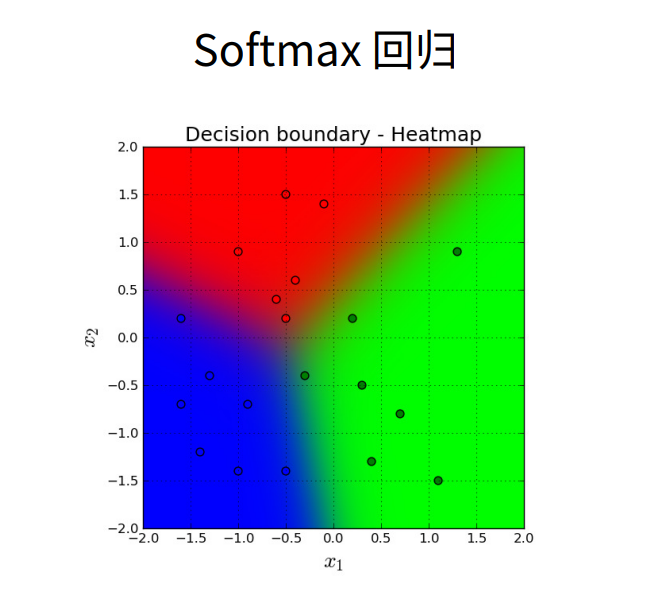
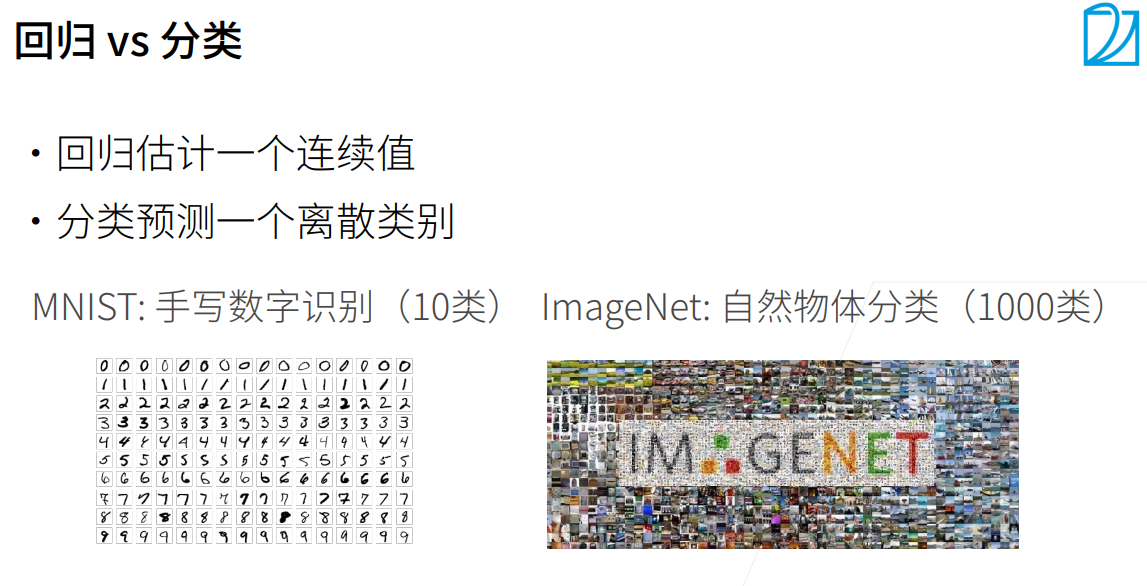
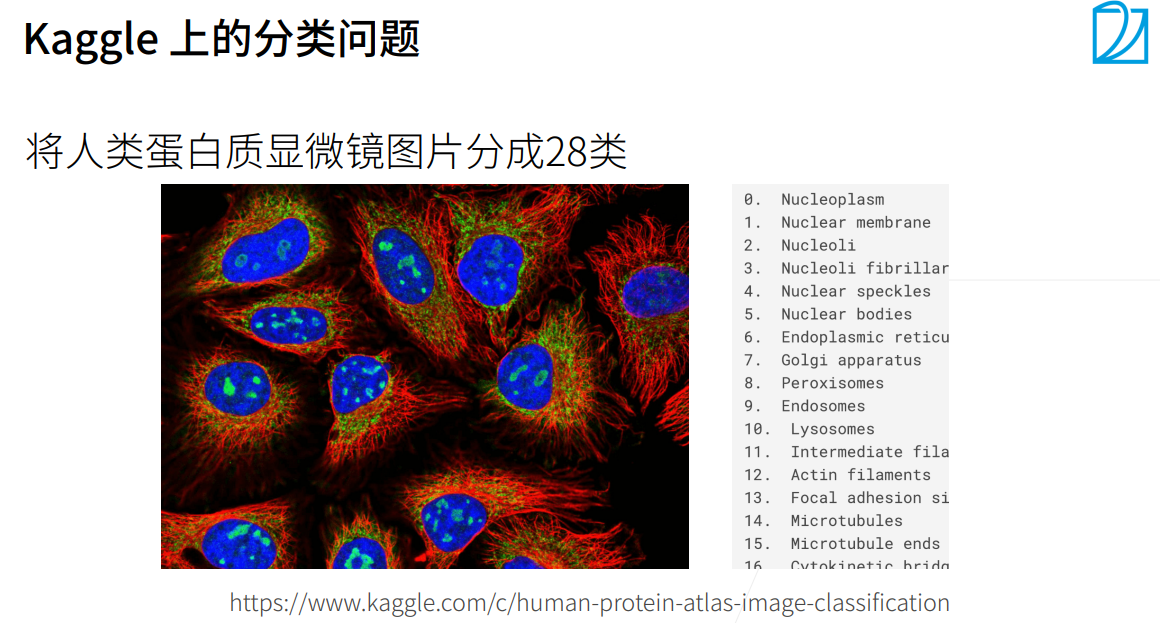


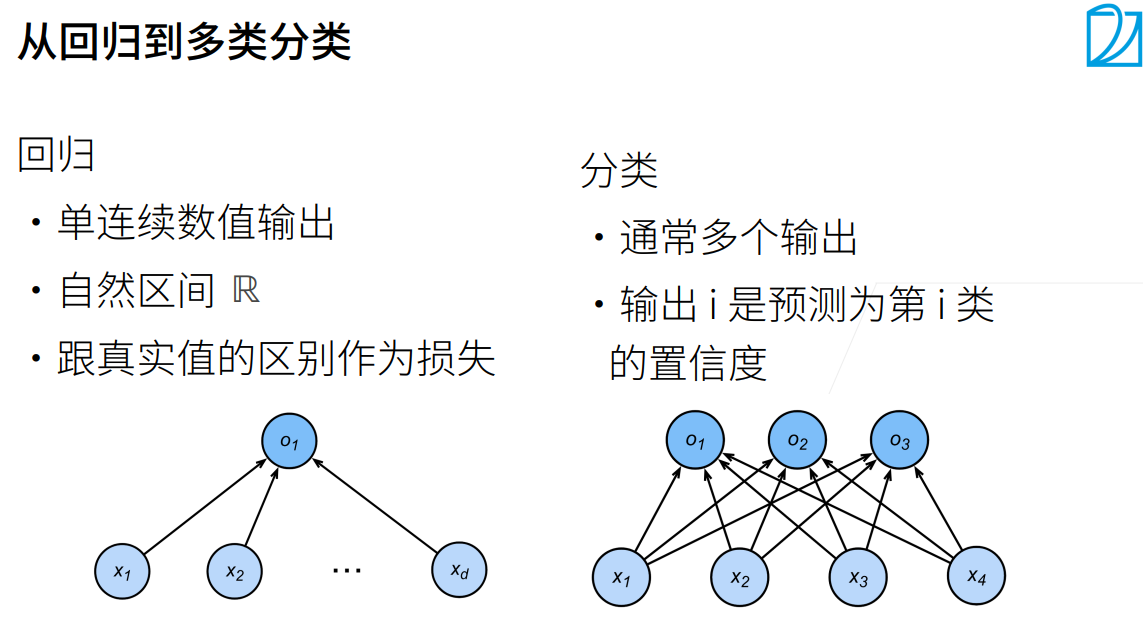

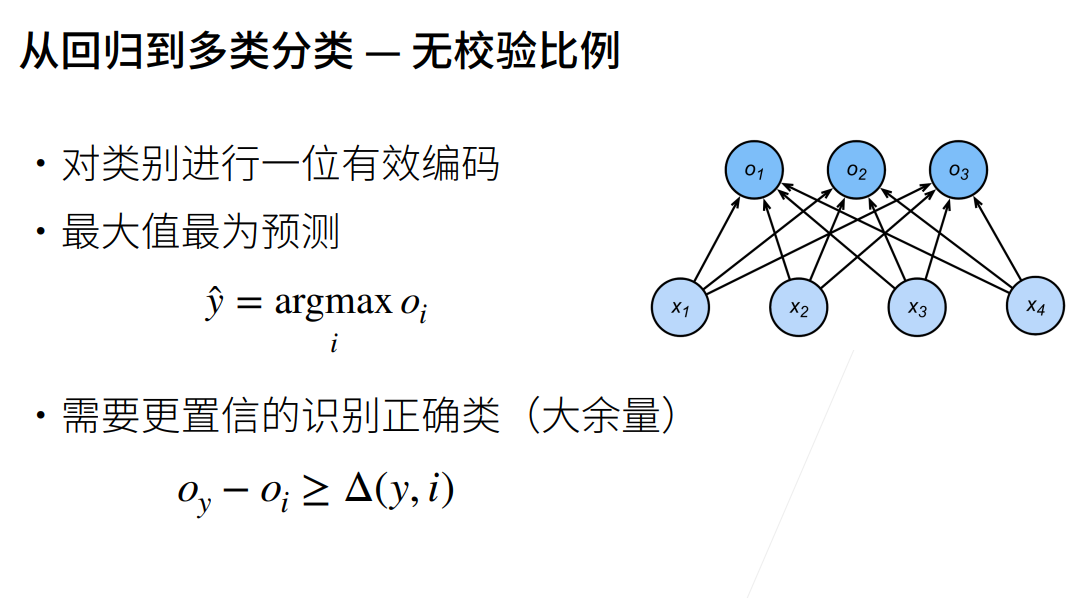
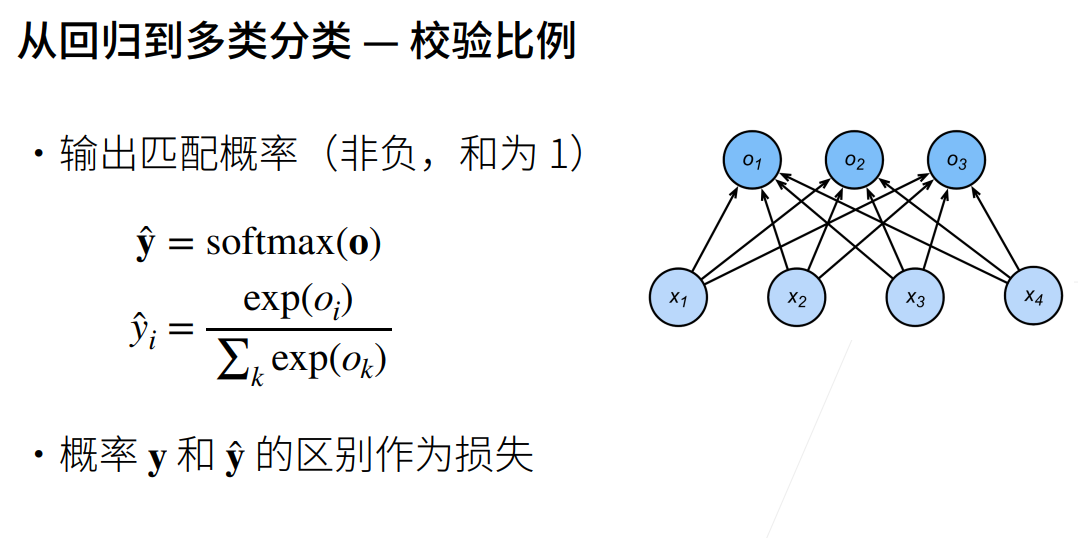
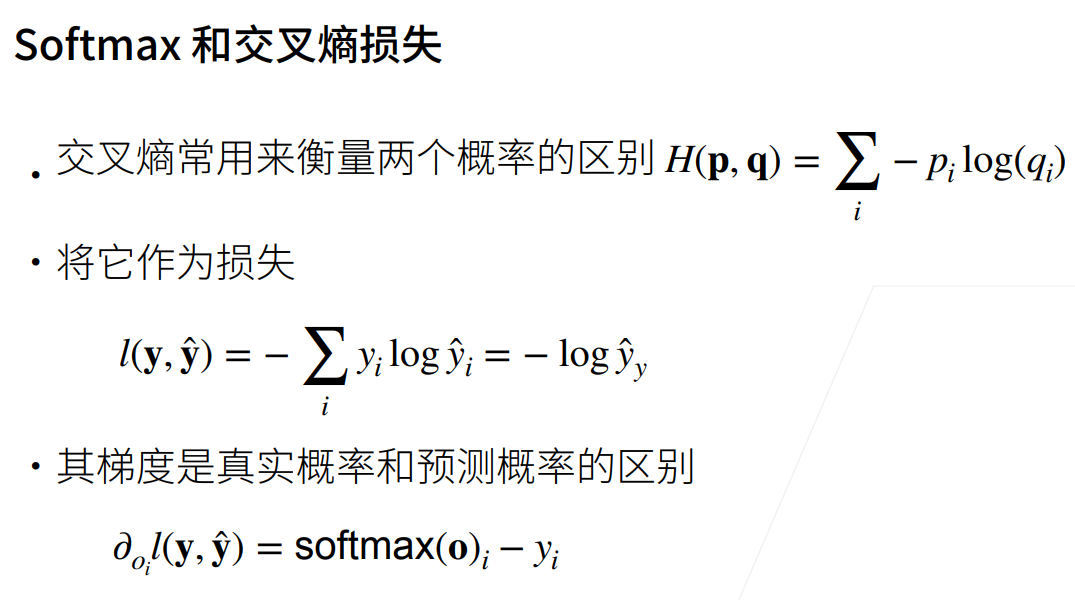
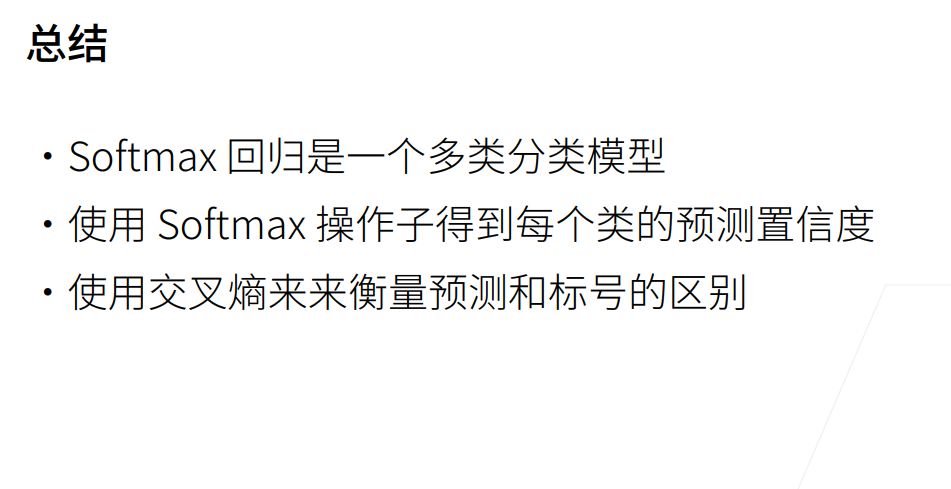
2.损失函数
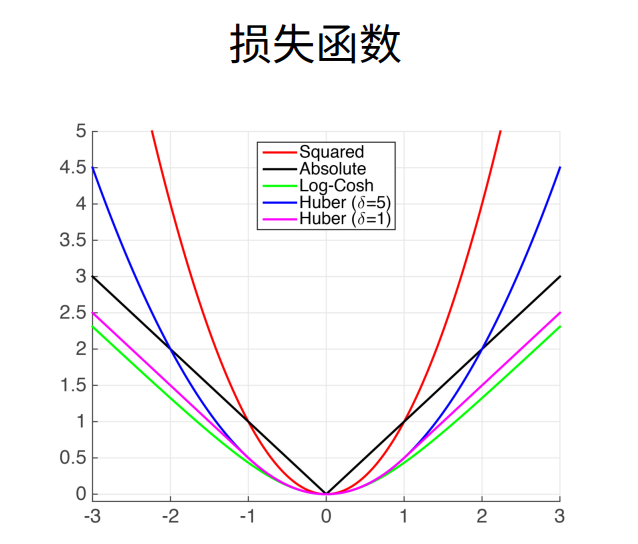





 3.图片分类数据集
3.图片分类数据集
# MNIST数据集是图像分类中广泛使用的数据集之一,但作为基准数据集过于简单。我们将使用类似但复杂的Fashion-MNIST数据集
import torch
import torchvision
from torch.utils import data
from torchvision import transforms
from d2l import torch as d2l
import os
import matplotlib.pyplot as plt
os.environ["KMP_DUPLICATE_LIB_OK"] = "TRUE"
d2l.use_svg_display()
# 通过框架中的内置函数将Fashion-MINIST数据集下载并读取到内存中
# 通过ToTensor实例将图像数据从PIL类型变换成32位浮点数格式
# 并除以255使得所有像素的数值均在0到1之间
trans = transforms.ToTensor()
mnist_train = torchvision.datasets.FashionMNIST(root=r'C:\Users\mm\Desktop\FashionMNIST', train=True,
transform=trans, download=True)
mnist_test = torchvision.datasets.FashionMNIST(root=r'C:\Users\mm\Desktop\FashionMNIST', train=False,
transform=trans, download=True)
print(len(mnist_train))
print(len(mnist_test))
print(mnist_train[0][0].shape)
# 两个可视化数据集的函数
def get_fashion_mnist_labels(labels):
'''返回Fashion-MNIST数据集的文本标签'''
text_labels = [
't-shirt', 'trouser', 'pullover', 'dress', 'coat', 'sandal', 'shirt','sneaker', 'bag', 'ankle boot'
]
return [text_labels[int(i)] for i in labels]
def show_images(imgs, num_rows, num_cols, titles=None, scale=1.5):
'''Plot a list of images.'''
figsize = (num_cols * scale, num_rows * scale)
_, axes = d2l.plt.subplots(num_rows, num_cols, figsize=figsize)
axes = axes.flatten()
for i, (ax, img) in enumerate(zip(axes, imgs)):
if torch.is_tensor(img):
# 图片张量
ax.imshow(img.numpy())
else:
# PIL图片
ax.imshow(img)
ax.axes.get_xaxis().set_visible(False)
ax.axes.get_yaxis().set_visible(False)
if titles:
ax.set_title(titles[i])
plt.show()
return axes
# 几个样本的图像及其相应的标签
X, y = next(iter(data.DataLoader(mnist_train, batch_size=18)))
show_images(X.reshape(18, 28, 28), 2, 9, titles=get_fashion_mnist_labels(y))
# 读取一小批量数据,大小为batch_size
batch_size = 256
def get_dataloader_workers():
'''使用4个进程来读取的数据'''
return 4
train_iter = data.DataLoader(mnist_train, batch_size, shuffle=True, num_workers=get_dataloader_workers())
timer = d2l.Timer()
for X, y in train_iter:
continue
print(f'{timer.stop():.2f} sec')
# 定义load_data_fashion_mnist函数
def load_data_fashion_mnist(batch_size, resize=None):
'''下载Fashion-MNIST数据集,然后将其加载到内存中'''
trans = [transforms.ToTensor()]
if resize:
trans.insert(0, transforms.Resize(resize))
trans = transforms.Compose(trans)
mnist_train = torchvision.datasets.FashionMNIST(root=r'C:\Users\mm\Desktop\FashionMNIST', train=True, transform=trans, download=True)
mnist_test = torchvision.datasets.FashionMNIST(root=r'C:\Users\mm\Desktop\FashionMNIST', train=False, transform=trans, download=True)
return (data.DataLoader(mnist_train, batch_size, shuffle=True, num_workers=get_dataloader_workers()),
data.DataLoader(mnist_train, batch_size, shuffle=False, num_workers=get_dataloader_workers()))
train_iter, test_iter = load_data_fashion_mnist(32, resize=64)
for X, y in train_iter:
print(X.shape, X.dtype, y.shape, y.dtype)
break
60000
10000
torch.Size([1, 28, 28]) 
4.76 sec
torch.Size([32, 1, 64, 64]) torch.float32 torch.Size([32]) torch.int644. Softmax回归的从零开始实现
import torch
from IPython import display
from d2l import torch as d2l
import matplotlib.pyplot as plt
import os
os.environ["KMP_DUPLICATE_LIB_OK"] = "TRUE"
batch_size = 256
train_iter, test_iter = d2l.load_data_fashion_mnist(batch_size)
# 将展平每个图像,将它们视为长度为784的向量。因为我们的数据集有10个类别,所以网络输出维度为10
num_inputs = 784
num_outputs = 10
W = torch.normal(0, 0.01, size=(num_inputs, num_outputs), requires_grad=True)
b = torch.zeros(num_outputs, requires_grad=True)
# 给定一个矩阵X,我们可以对所有元素求和
X = torch.tensor([[1.0, 2.0, 3.0], [4.0, 5.0, 6.0]])
print(X.sum(0, keepdim=True))
print(X.sum(1, keepdim=True))
def softmax(X):
X_exp = torch.exp(X)
partition = X_exp.sum(1, keepdim=True)
return X_exp / partition # 这里应用了广播机制
# 我们将每个元素变成一个非负数,此外,依据概率原理,每行总和为1
X = torch.normal(0, 1, (2, 5))
X_prob = softmax(X)
print(X_prob)
print(X_prob.sum(1))
# 实现Softmax回归模型
def net(X):
return softmax(torch.matmul(X.reshape((-1, W.shape[0])), W) + b)
# 创建一个数据y_hat,其中包含2个样本和3个类别的预测概率,使用y作为y_hat中概率的索引
y = torch.tensor([0, 2])
y_hat = torch.tensor([[0.1, 0.3, 0.6], [0.3, 0.2, 0.5]])
print(y_hat[[0, 1], y])
# 实现交叉熵损失函数
def cross_entropy(y_hat, y):
return -torch.log(y_hat[range(len(y_hat)), y])
print(cross_entropy(y_hat, y))
# 将预测类别与真实y元素进行比较
def accuracy(y_hat, y):
'''计算预测正确的数量'''
if len(y_hat.shape) > 1 and y_hat.shape[1] > 1:
y_hat = y_hat.argmax(axis=1)
cmp = y_hat.type(y.dtype) == y
return float(cmp.type(y.dtype).sum())
accuracy(y_hat, y) / len(y)
# Accumulator实例中创建了2个变量,用于分别存储正确预测的数量和预测的总数量
class Accumulator:
'''在n个变量上累加'''
def __init__(self, n):
self.data = [0.0] * n
def add(self, *args):
self.data = [a + float(b) for a, b in zip(self.data, args)]
def reset(self):
self.data = [0.0] * len(self.data)
def __getitem__(self, idx):
return self.data[idx]
# 我们可以评估在任意模型net的准确率
def evaluate_accuracy(net, data_iter):
'''计算在指定数据集上模型的精度'''
if isinstance(net, torch.nn.Module):
net.eval() # 将模型设置为评估模式
metric = Accumulator(2) # 正确预测数、预测总数
for X, y in data_iter:
metric.add(accuracy(net(X), y), y.numel())
return metric[0] / metric[1]
# Softmax回归的训练
def train_epoch_ch3(net, train_iter, loss, updater):
if isinstance(net, torch.nn.Module):
net.train()
metric = Accumulator(3)
for X, y in train_iter:
y_hat = net(X)
l = loss(y_hat, y)
if isinstance(updater, torch.optim.Optimizer):
updater.zero_grad()
l.backward()
updater.step()
metric.add(
float(l) * len(y), accuracy(y_hat, y), y.size().numel())
else:
l.sum().backward()
updater(X.shape[0])
metric.add(float(l.sum()), accuracy(y_hat, y), y.numel())
return metric[0] / metric[2], metric[1] / metric[2]
# 定义一个在动画中绘制数据的实用程序类
class Animator:
# 在动画中绘制数据
def __init__(self, xlabel=None, ylabel=None, legend=None, xlim=None, ylim=None, xscale='linear', yscale='linear', fmts=('-', 'm--', 'g-.', 'r:'), nrows=1, ncols=1, figsize=(3.5, 2.5)):
# 增量地绘制多条线
if legend is None:
legend = []
d2l.use_svg_display()
self.fig, self.axes = d2l.plt.subplots(nrows, ncols, figsize=figsize)
if nrows * ncols == 1:
self.axes = [self.axes,]
# 使用lambda函数捕获参数
self.config_axes = lambda: d2l.set_axes(self.axes[0], xlabel, ylabel, xlim, ylim, xscale, yscale, legend)
self.X, self.Y, self.fmts = None, None, fmts
def add(self, x, y):
# 向图表中添加多个数据点
if not hasattr(y, '__len__'):
y = [y]
n = len(y)
if not hasattr(x, '__len__'):
x = [x] * n
if not self.X:
self.X = [[] for _ in range(n)]
if not self.Y:
self.Y = [[] for _ in range(n)]
for i, (a, b) in enumerate(zip(x, y)):
if a is not None and b is not None:
self.X[i].append(a)
self.Y[i].append(b)
self.axes[0].cla()
for x, y, fmt in zip(self.X, self.Y, self.fmts):
self.axes[0].plot(x, y, fmt)
self.config_axes()
display.display(self.fig)
display.clear_output(wait=True)
# 训练函数
def train_ch3(net, train_iter, test_iter, loss, num_epochs, updater):
'''训练模型'''
animator = Animator(xlabel='epoch', xlim=[1, num_epochs], ylim=[0.3, 0.9], legend=['train loss', 'train acc', 'test acc'])
for epoch in range(num_epochs):
train_metrics = train_epoch_ch3(net, train_iter, loss, updater)
test_acc = evaluate_accuracy(net, test_iter)
animator.add(epoch + 1, train_metrics + (test_acc,))
train_loss, train_acc = train_metrics
assert train_loss < 0.5, train_loss
assert 1 >= train_acc > 0.7, train_acc
assert 1 >= test_acc > 0.7, test_acc
plt.show()
lr = 0.1
def updater(batch_size):
return d2l.sgd([W, b], lr, batch_size)
# 训练模型10个迭代周期
num_epochs = 10
train_ch3(net, train_iter, test_iter, cross_entropy, num_epochs, updater)
# 对图像进行分类预测
def predict_ch3(net, test_iter, n=6):
'''预测标签'''
for X, y in test_iter:
break
trues = d2l.get_fashion_mnist_labels(y)
preds = d2l.get_fashion_mnist_labels(net(X).argmax(axis=1))
titles = [true + '\n' + pred for true, p red in zip(trues, preds)]
d2l.show_images(
X[0:n].reshape((n, 28, 28)), 1, n, titles=titles[0:n]
)
plt.show()
predict_ch3(net, test_iter)
tensor([[5., 7., 9.]])
tensor([[ 6.],
[15.]])
tensor([[0.1659, 0.3020, 0.2751, 0.0552, 0.2018],
[0.1170, 0.1502, 0.0258, 0.5928, 0.1143]])
tensor([1.0000, 1.0000])
tensor([0.1000, 0.5000])
tensor([2.3026, 0.6931])
<Figure size 350x250 with 1 Axes>
<Figure size 350x250 with 1 Axes>
<Figure size 350x250 with 1 Axes>
<Figure size 350x250 with 1 Axes>
<Figure size 350x250 with 1 Axes>
<Figure size 350x250 with 1 Axes>
<Figure size 350x250 with 1 Axes>
<Figure size 350x250 with 1 Axes>
<Figure size 350x250 with 1 Axes>
<Figure size 350x250 with 1 Axes>5.Softmax回归的简洁实现
# 通过深度学习框架的高级API能够使实现softmax回归变得更加容易
import torch
from torch import nn
from d2l import torch as d2l
import os
import matplotlib.pyplot as plt
os.environ["KMP_DUPLICATE_LIB_OK"] = "TRUE"
batch_size = 256
train_iter, test_iter = d2l.load_data_fashion_mnist(batch_size)
# Softmax回归的输出层是一个全连接层
# PyTorch不会隐式地调整输入的形状
# 因此,我们定义了展平层(flatten)在线性层前调整网络输入的形状
net = nn.Sequential(nn.Flatten(), nn.Linear(784, 10))
def init_weights(m):
if type(m) == nn.Linear:
nn.init.normal_(m.weight, std=0.01)
net.apply(init_weights)
# 在交叉熵损失函数中传递未归一化的预测,并同时计算softmax及其对数
loss = nn.CrossEntropyLoss()
# 使用学习率为0.1的小批量随机梯度下降作为优化算法
trainer = torch.optim.SGD(net.parameters(), lr=0.1)
# 调用之前定义的训练函数来训练模型
num_epochs = 10
d2l.train_ch3(net, train_iter, test_iter, loss, num_epochs, trainer)
plt.show()<Figure size 350x250 with 1 Axes>
<Figure size 350x250 with 1 Axes>
<Figure size 350x250 with 1 Axes>
<Figure size 350x250 with 1 Axes>
<Figure size 350x250 with 1 Axes>
<Figure size 350x250 with 1 Axes>
<Figure size 350x250 with 1 Axes>
<Figure size 350x250 with 1 Axes>
<Figure size 350x250 with 1 Axes>
<Figure size 350x250 with 1 Axes>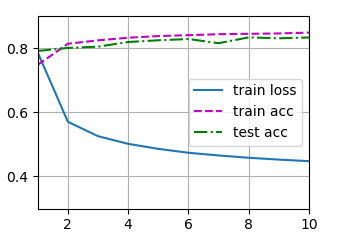























 2755
2755











 被折叠的 条评论
为什么被折叠?
被折叠的 条评论
为什么被折叠?








